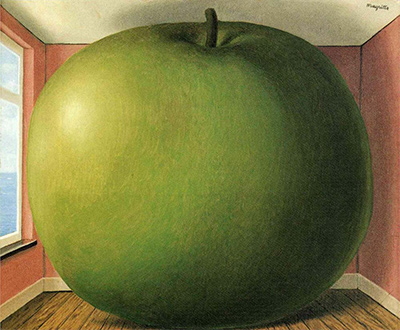The Listening Room (1952) is a significant artwork along Magritte's common theme of using apples for symbolism.
It features an apple in a pink room with a white ceiling, wooden floors and a white-trimmed window with a view of what appears to be an ocean or a field. Light streams in through the window to illuminate the immense apple and create a shadow on the wall.
In this painting, the symbol of the apple is represented as being large enough to fill an entire room. Or, is the apple in it's normal size and the room is miniature? This is where Magritte's style creates viewers to ask questions about his paintings.
Viewers may also wonder if the apple is hiding anything like it does in some other paintings. Magritte actually made two versions of this painting.
Questions also arise as to why the painting is titled The Listening Room because there isn't anything to suggest it is a room for listening to anything or anyone. This is yet another aspect of the painting to get viewers to think outside the box and perhaps listen to their thoughts.
Magritte redid this painting in 1958 for the cover of the album Beck-Ola by British rock band The Jeff Beck Group with a grey brick room and an arched open-air window. This version is held in a private collection while the original is part of the Menil Collection in Houston, Texas.
Magritte's other works were also featured on other album covers, in movies and inspired other artists in various artist movements.
As mentioned, Magritte's paintings were part of the surrealism movement. They were characterized by the use of everyday objects in unusual settings or contexts. Magritte would make a new meaning for these objects and force people to think outside the box.
This style would also make poetic imagery as well as a play between reality and illusion. Art analysts believe this particular aspect of his paintings is linked to his mother's death because Magritte would have been going back and forth between the reality of his mother's death and the illusion that he still wants her to be alive.
Despite this analysis of the meanings behind his paintings, Magritte says his paintings don't have any mystery because they show objects in their true forms.
One of these objects that appears often in Magritte's paintings is an apple. This object is interpreted as representing the relationship between the hidden and the visible, similar to the tension between illusion and reality. Magritte talked about his use of an apple as creating a new meaning to the apple. It causes viewers to wonder if the apple is hiding anything and why the apple is in the painting at all.
While apples are basic objects that have a certain meaning, Magritte heightens their significance by using them in his paintings. These paintings include: The Hesitation Waltz (1950), Memory of a Voyage (1951), The Listening Room (1952), Force of Habit (1960), The Postcard (1960), Beautiful World (1962), The Great Table (1963), Fine Realities (1964), The Son of Man (1964), The Great War (1964), This is Not an Apple (1964) and The Great Table (1965).
René François Ghislain Magritte was an influential Belgian surrealist artist. Born in 1898 in Lessines, Belgium, relatively little is known of his childhood with the exception of his mother's suicide when he was in his early teen years. This tragic event is believed to have inspired some of Magritte's paintings. His earliest paintings are dated to circa 1915 before he studied at the Académie Royale des Beaux-Arts in Brussels from 1916-1918. Magritte did not find these years very inspiring but this did not stop his career. Years later, in 1926, his career really began when he painted his first surrealist work, The Lost Jockey, and had an exhibition in Brussels in 1927. While the exhibition did not receive good reviews, Magritte did not get discouraged. Instead, he moved to Paris and joined the surrealist group which would inspire his future creations.
His time in Paris only lasted a couple of years and he lived in London for a short time as well. During World War II, Magritte lived in Brussels while Belgium was under occupation by Germany. He dabbled in some other painting styles during this time that reflected his feelings of alienation but returned to his characteristic style after the war. Magritte's popularity grew after the war and he was able to exhibit some works in New York. The 1960s saw a large growth in interest in his works. His paintings also had influence in music and future artists. In 1967, Magritte passed away from pancreatic cancer in 1967 at the age of 68 in Brussels, Belgium.




